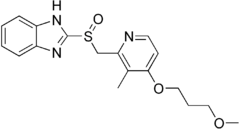Rabeprazole
 | |
 | |
| Systematic (IUPAC) name | |
|---|---|
| (RS)-2-([4-(3-methoxypropoxy)-3-methylpyridin-2-yl]methylsulfinyl)-1H-benzo[d]imidazole | |
| Clinical data | |
| Trade names | Aciphex, Acifix (by Beximco) |
| AHFS/Drugs.com | monograph |
| MedlinePlus | a699060 |
| Licence data | US FDA:Finix&SearchType=BasicSearch link |
| |
| |
| Oral | |
| Pharmacokinetic data | |
| Bioavailability | 52% |
| Metabolism |
mostly non-enzymatic, partly hepatic (CYP2C19) |
| Half-life | 1 - 1.5 hours |
| Excretion | 90% renal |
| Identifiers | |
|
117976-89-3 | |
| A02BC04 | |
| PubChem | CID 5029 |
| DrugBank |
DB01129 |
| ChemSpider |
4853 |
| UNII |
32828355LL |
| ChEBI |
CHEBI:8768 |
| ChEMBL |
CHEMBL1219 |
| PDB ligand ID | RZX (PDBe, RCSB PDB) |
| Chemical data | |
| Formula | C18H21N3O3S |
| 359.444 g/mol | |
|
SMILES
| |
| |
| | |
Rabeprazole /ˌræ.ˈbɛp.ræ.zɔːl/ is an antiulcer drug in the class of proton pump inhibitors. It was developed by Eisai Co. and is available worldwide under many brand names.
Indications and usage
Short-term treatment in healing and symptomatic relief of duodenal ulcers and erosive or gastroesophageal reflux disease (GERD); maintaining healing and reducing relapse rates of heartburn symptoms in patients with GERD; treatment of daytime and nighttime heartburn and other symptoms associated with GERD; long-term treatment of pathological hypersecretory conditions, including Zollinger-Ellison syndrome and in combination with amoxicillin and clarithromycin to eradicate Helicobacter pylori.
- Gastric ulcer (GU)
- Peptic ulcer disease (PUD)
- Maintenance of healing of erosive or ulcerative GERD
- Healing of erosive and ulcerative GERD
- Healing of duodenal ulcers.
- Treatment of symptomatic GERD
- Treatment of pathological hypersecretory conditions (Zollinger-Ellison syndrome)
- Helicobacter pylori eradication to reduce risk of duodenal ulcer recurrence
Contraindications
- hypersensitivity to rabeprazole, substituted benzimidazoles or any of components of its pharmaceutical forms.
- lactation: Thomson Lactation Ratings: Infant risk cannot be ruled out.
Restriction of usage

- acute liver failure
- pediatric use in patients under 18 years of age (there are insufficient data about safety and efficiency of rabeprazole in this group of patients)
Side effects
Rabeprazole adverse reactions/side effects include:
- In clinical trials the most common side effect assessed as possibly or probably related to AcipHex was headache in 2.4% of patients vs 1.6% taking placebo.
- abdominal pains
- anxiety
- arthralgia
- asthenia
- constipation
- diarrhea
- dry mouth
- erythema
- granulocytopenia
- headache
- increased or decreased appetite
- insomnia
- leukocytopenia
- meteorism
- muscle or bone pain
- myalgia
- nausea
- skin eruption
- thrombocytopenia
- vertigo
- vomiting
Drug interactions
Rabeprazole decreases the concentration of ketoconazole in the plasma (in 33%), increases the concentration of digoxin (in 22%), and does not interact with liquid antacids. Rabeprazole is compatible with any medicine metabolized by the CYP450 (theophylline, warfarin, diazepam, phenytoin).
Overdosage
Studies in mice and rats indicated the symptoms of acute toxicity due to overdose included: hypoactivity, labored respiration, convulsion, diarrhea, tremor, and coma. A study in dogs indicated that a dose of 2000 mg/kg was not lethal.
Formulations and brand names
Rabeprazole is available under many brand names worldwide.[1]
References
- ↑ drugs.com International availability of Rabeprazole via drugs.com Page accessed April 22, 2015
- Morii M, Takata H, Fujisaki H, Takeguchi N., The potency of substituted benzimidazoles such as E3810, omeprazole, Ro 18-5364 to inhibit gastric H+, K(+)-ATPase is correlatedwith the rate of acid-activation of the inhibitor, Biochem. Pharmacol. 1990 Feb 15;39(4):661-7.
- Prakash A, Faulds D., Rabeprazole, Drugs. 1998 Feb;55(2):261-7; discussion 268.
External links
| ||||||||||||||||||||||||||||||||||||||||||||